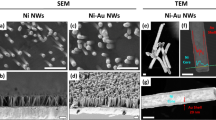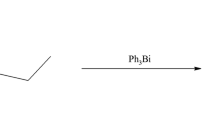Abstract
Neuroprosthetic technologies for therapeutic neuromodulation have seen major advances in recent years but these advances have been impeded due to electrode failure or a temporal deterioration in the device recording or electrical stimulation potential. This deterioration is attributed to an intrinsic host tissue response, namely glial scarring or gliosis, which prevents the injured neurons from sprouting, drives neurite processes away from the neuroelectrode and increases signal impedance by increasing the distance between the electrode and its target neurons. To address this problem, there is a clinical need to reduce tissue encapsulation of the electrodes in situ and improve long-term neuroelectrode function. Nanotopographical modification has emerged as a potent methodology for the disruption of protein adsorption and cellular adhesion in vitro. This study investigates the use of block copolymer self-assembly technique for the generation of sub-20 nm nanowire features on silicon substrates. Critically, these nanostructures were observed to significantly reduce electrical impedance and increase conductivity. Human neuroblastoma SH-SY5Y cells cultured on nanowire substrates for up to 14 days were associated with enhanced focal adhesion reinforcement and a reduction in proliferation. We conclude that nanowire surface modulation may offer significant potential as an electrode functionalization strategy.




Similar content being viewed by others
References
Green RA, Lovell NH, Wallace GG, Poole-Warren LA. Conducting polymers for neural interfaces: challenges in developing an effective long-term implant. Biomaterials. 2008;29:3393–9.
Dalby MJ, Gadegaard N, Tare R, Andar A, Riehle MO, Herzyk P, et al. The control of human mesenchymal cell differentiation using nanoscale symmetry and disorder. Nat Mater. 2007;6:997–1003.
Hammarin G, Persson H, Dabkowska AP, Prinz CN. Enhanced laminin adsorption on nanowires compared to flat surfaces. Colloids Surf B. 2014;122C:85–9.
Kam KR, Walsh LA, Bock SM, Ollerenshaw JD, Ross RF, Desai TA. The effect of nanotopography on modulating protein adsorption and the fibrotic response. Tissue Eng Part A. 2014;20:130–8.
Mokarian-Tabari P, Collins TW, Holmes JD, Morris MA. Cyclical “Flipping” of morphology in block copolymer thin films. ACS Nano. 2011;5:4617–23.
Sinturel C, Vayer M, Morris M, Hillmyer MA. Solvent vapor annealing of block polymer thin films. Macromolecules. 2013;46:5399–415.
Ghoshal T, Maity T, Godsell JF, Roy S, Morris MA. Large scale monodisperse hexagonal arrays of superparamagnetic iron oxides nanodots: a facile block copolymer inclusion method. Adv Mater. 2012;24:2390–7.
Johnson MD, Otto KJ, Kipke DR. Repeated voltage biasing improves unit recordings by reducing resistive tissue impedances. IEEE Trans Neural Syst Rehabil Eng. 2005;13:160–5.
Dorman MF, Smith LM, Dankowski K, McCandless G, Parkin JL. Long-term measures of electrode impedance and auditory thresholds for the Ineraid cochlear implant. J Speech Hear Res. 1992;35:1126–30.
De Ceulaer G, Johnson S, Yperman M, Daemers K, Offeciers FE, O’Donoghue GM, et al. Long-term evaluation of the effect of intracochlear steroid deposition on electrode impedance in cochlear implant patients. Otol Neurotol. 2003;24:769–74.
Fakhar K, Hastings E, Butson CR, Foote KD, Zeilman P, Okun MS. Management of deep brain stimulator battery failure: battery estimators, charge density, and importance of clinical symptoms. PLoS One. 2013;8:e58665.
Butson CR, Maks CB, McIntyre CC. Sources and effects of electrode impedance during deep brain stimulation. Clin Neurophysiol. 2006;117:447–54.
Kay AD, McIntyre MD, Macrae WA, Varma TR. Spinal cord stimulation—a long-term evaluation in patients with chronic pain. Br J Neurosurg. 2001;15:335–41.
Quigley DG, Arnold J, Eldridge PR, Cameron H, McIvor K, Miles JB, et al. Long-term outcome of spinal cord stimulation and hardware complications. Stereotact Funct Neurosurg. 2003;81:50–6.
Wei XF, Grill WM. Current density distributions, field distributions and impedance analysis of segmented deep brain stimulation electrodes. J Neural Eng. 2005;2:139–47.
Williams JC, Hippensteel JA, Dilgen J, Shain W, Kipke DR. Complex impedance spectroscopy for monitoring tissue responses to inserted neural implants. J Neural Eng. 2007;4:410–23.
Borah D, Shaw MT, Rasappa S, Farrell RA, O’Mahony C, Faulkner CM, et al. Plasma etch technologies for the development of ultra-small feature size transistor devices. J Phys D. 2011;44:12.
Wei XF, Grill WM. Impedance characteristics of deep brain stimulation electrodes in vitro and in vivo. J Neural Eng. 2009;6:046008.
Biggs MJ, Capdevila EP, Vallejo-Giraldo G, Wind S. Cellular response to ferroelectric PVDF-TrFE nanoscale surfaces formed by varying polymer concentration. Pharm Nanotechnol. 2014;2:42–8.
Acknowledgments
The authors would like to acknowledge (AMBER) Advanced Materials and BioEngineering Research and (SFI) Science Foundation Ireland for funding through SFI-AMBER (Grant No. SFI 12/RC/2278 AMBER). We acknowledge the joint funding received from Irish Research Council through IRC New Foundation Scheme/Nano Surface project. Also the authors thank Advance Microscopy Laboratory (AML)/CRANN for their collaboration and facilities. Bell Labs Ireland thanks the Industrial Development Agency (IDA) Ireland for their financial support. M. J. Biggs is a Science Foundation Ireland, Starting Investigator SIRG COFUND fellow, Grant No. 11/SIRG/B2135.
Author information
Authors and Affiliations
Corresponding authors
Rights and permissions
About this article
Cite this article
Mokarian-Tabari, P., Vallejo-Giraldo, C., Fernandez-Yague, M. et al. Nanoscale neuroelectrode modification via sub-20 nm silicon nanowires through self-assembly of block copolymers. J Mater Sci: Mater Med 26, 120 (2015). https://doi.org/10.1007/s10856-015-5426-2
Received:
Accepted:
Published:
DOI: https://doi.org/10.1007/s10856-015-5426-2




